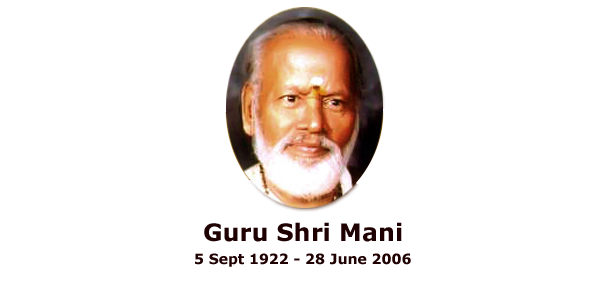Guru Shri Mani
Moorkanikara Parameshwara Mani

Born in 1922 on the 5th of September in a small village of Trisshur, the cultural centre of Kerala, Guru Mani was the eldest son in a family of 10 children. His father was a Maths teacher in the local St. Thomas school and was a very strict father and teacher.
Guruji was a brilliant student, particularly good in Sanskrit, English and Maths, endowed with beautiful handwriting. He was awarded a scholarship in recognition of his academic excellence. After his education, he came to Mumbai to earn a living. He was employed with the International Book House where he started as a clerk and very soon became a librarian. His inner love and interest for Indian art and culture along with his association with like minded colleagues culminated in the forming of Chetana Cultural Center, a pioneer group that organized many performances for various artistes in Mumbai during the period between 1940--50. Simultaneously, he also learnt Bharatanatyam from Guru Smt.Karunambal and her husband Shri.Guru Govindaraja Pillai, under the guidance of Bharata Vidwan Guru Shri Kuppaiah Pillai of the Raja Rajeshwari Bharatnatya Kala Mandir.
He stood first in the practical and theoretical examination in Bharatnatyam held by Government School of Music and Dance of Hyderabad in 1952. He was offered to take charge of the institution as Principal but he declined it since its rules restricted his creative freedom. He came back to Mumbai and started the Kalasadan Institute of Fine Arts in 1954 to serve the cause of Fine Arts in a manner, which he dreamt and visualized. In the initial stages he led a very hard and difficult life due to various constraints including financial. As one of his students remembers, in the initial days, when he came by for the dance lessons and was offered food he would have it thinking, he could save the money to travel by bus and not walk back.
He came from a Brahmin family at a time when people looked down upon dance. It was a fairly rebellious decision to follow his interest in the art form. His inspiration was E. Krishna Iyer and Rukmini Devi Arundale, who were Brahmins themselves but fought the social stigma attached to the dance form to bring it to the fore.
By nature, he was a very affectionate and benevolent teacher. As a guru, he was a picture of humility and compassion, never tired or bored of teaching or discussing about music or dance. He always thought of new ideas to propagate dance. In fact, Guruji was a very graceful dancer himself. His guru Karunambal would many times say that many of his steps were done more gracefully than the girls. He would have won name and fame as an exponent of Bharatnatyam, had it not been for his sacrifice on a personal level to utilize his talent and resources for a larger benefit.
All the students at Kalasadan, started the learning journey with him. He never had any other teacher or an assistant, he would teach even the beginners. He had an open mind and believed that there was a lot to learn from the children who came to learn from him. He taught them with a lot of enthusiasm and interest. He had an innate ability to gauge the potential and talent of his students. He had a spiritual connect with his students and could visualize them in roles he designed.
He was multifaceted, a great organizer, with brilliant planning abilities. His visualization and creativity was often, ahead of his time. He was a highly spiritual man and an' ardent devotee of Mumbai's Mahalaxmi temple.
Simple living and high thinking summarized his lifestyle as a revered teacher, a creative choreographer and an astute organizer. The cultural fraternity of our country held him in high esteem.
Even amongst noted dignitaries, he was always himself. He was a very well read person who could recite quotes from well-known books and writers such as Somerset Maugham, Bernard Shaw, Stephen Zweigh, William Shakespeare etc.
In the later years of his career, he focused on creating the Chintamani Ashram of Fine Arts. It was his dream to create an abode for fine arts where any form of art could be preserved and spread across the masses, where individuals were not limited by their economic conditions to explore their talent.
He died on 28th of June,2006 at the age of 84. Till his last breath he was actively involved in all the activities of the institute.
"The highest art is always the most religious, and the greatest artiste is always a devout man." Guru Shishya Parampara.


